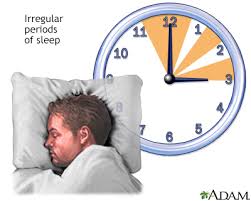 Irregular sleep–wake rhythm disorder (ISWRD) is a rare form of circadian rhythm sleep disorder.
Irregular sleep–wake rhythm disorder (ISWRD) is a rare form of circadian rhythm sleep disorder.
ISWRD is characterized by numerous naps throughout the 24-hour period, no main nighttime sleep episode, and irregularity from day to day.
Affected individuals have no pattern of when they are awake or asleep, may have poor quality sleep, and often may be very sleepy while they are awake.
The total time asleep per 24 hours is normal for the person’s age.
ISWRD disorder is serious being an invisible disability, and create social, familial, and work problems, making it hard for a person to maintain relationships and responsibilities, and may make a person home-bound and isolated.
ISWRD has various causes, including neurological disorders such as dementia, particularly Alzheimer’s disease, brain damage, or intellectual disabilities.
ISWRD is thought that those affected have a weak circadian clock.
The risk for the disorder increases with age and due to increased prevalence of co-morbid medical disorders.
Polysomnography charts brain waves, heart beat, muscle activity, and breathing during sleep and will show if there are other sleep disorders that are causing or increasing the problems with ISWRD.
Management
Education about sleep hygiene is important, and counseling can be helpful.
Melatonin, vitamin B12, sleep aids, wake aids, and other medications may also be used.
Exposure to light during the daytime and activities occurring at regular times each day may help to restore a normal rhythm.
Affected individuals with dementia should not be prescribed sleep-promoting medications (sedatives) for ISWRD due to the increased prevalence of adverse effects in this group outweighing the possible benefits.
